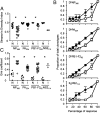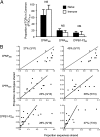Ecological analysis of antigen-specific CTL repertoires defines the relationship between naive and immune T-cell populations
- PMID: 23319654
- PMCID: PMC3562793
- DOI: 10.1073/pnas.1222149110
Ecological analysis of antigen-specific CTL repertoires defines the relationship between naive and immune T-cell populations
Abstract
Ecology is typically thought of as the study of interactions organisms have with each other and their environment and is focused on the distribution and abundance of organisms both within and between environments. On a molecular level, the capacity to probe analogous questions in the field of T-cell immunology is imperative as we acquire substantial datasets both on epitope-specific T-cell populations through high-resolution analyses of T-cell receptor (TCR) use and on global T-cell populations analyzed via high-throughput DNA sequencing. Here, we present the innovative application of existing statistical measures (used typically in the field of ecology), together with unique statistical analyses, to comprehensively assess how the naïve epitope-specific CD8(+) cytotoxic T lymphocyte (CTL) repertoire translates to that found following an influenza-virus-specific immune response. Such interrogation of our extensive, cumulated TCR CDR3β sequence datasets, derived from both naïve and immune CD8(+) T-cell populations specific for four different influenza-derived epitopes (D(b)NP(366), influenza nucleoprotein amino acid residues 366-374; D(b)PA(224), influenza acid polymerase amino acid residues 224-233; D(b)PB1-F2(62), influenza polymerase B 1 reading frame 2 amino acid residues 62-70; K(b)NS2(114), and influenza nonstructural protein 2 amino acid residues 114-121), demonstrates that epitope-specific TCR use in an antiviral immune response is the consequence of a complex interplay between the intrinsic characteristics of the naïve cytotoxic T lymphocyte precursor pool and extrinsic (likely antigen driven) influences, the contribution of which varies in an epitope-specific fashion.
Conflict of interest statement
The authors declare no conflict of interest.
Figures



Similar articles
-
Effect of MHC class I diversification on influenza epitope-specific CD8+ T cell precursor frequency and subsequent effector function.J Immunol. 2011 Jun 1;186(11):6319-28. doi: 10.4049/jimmunol.1000883. Epub 2011 May 2. J Immunol. 2011. PMID: 21536802 Free PMC article.
-
Paired TCRαβ analysis of virus-specific CD8(+) T cells exposes diversity in a previously defined 'narrow' repertoire.Immunol Cell Biol. 2015 Oct;93(9):804-14. doi: 10.1038/icb.2015.44. Epub 2015 Mar 25. Immunol Cell Biol. 2015. PMID: 25804828 Free PMC article.
-
Lack of prominent peptide-major histocompatibility complex features limits repertoire diversity in virus-specific CD8+ T cell populations.Nat Immunol. 2005 Apr;6(4):382-9. doi: 10.1038/ni1175. Epub 2005 Feb 27. Nat Immunol. 2005. PMID: 15735650
-
The molecular mechanisms of CD8+ T cell responses to SARS-CoV-2 infection mediated by TCR-pMHC interactions.Front Immunol. 2024 Oct 10;15:1468456. doi: 10.3389/fimmu.2024.1468456. eCollection 2024. Front Immunol. 2024. PMID: 39450171 Free PMC article. Review.
-
Specific T-cell activation in an unspecific T-cell repertoire.Sci Prog. 2011;94(Pt 3):245-64. doi: 10.3184/003685011X13139280383942. Sci Prog. 2011. PMID: 22026148 Free PMC article. Review.
Cited by
-
The ABC of Major Histocompatibility Complexes and T Cell Receptors in Health and Disease.Viral Immunol. 2020 Apr;33(3):160-178. doi: 10.1089/vim.2019.0184. Viral Immunol. 2020. PMID: 32286182 Free PMC article. Review.
-
Quantifying Distribution of Flow Cytometric TCR-Vβ Usage with Economic Statistics.PLoS One. 2015 Apr 29;10(4):e0125373. doi: 10.1371/journal.pone.0125373. eCollection 2015. PLoS One. 2015. PMID: 25923356 Free PMC article.
-
Interrogating the relationship between naïve and immune antiviral T cell repertoires.Curr Opin Virol. 2013 Aug;3(4):447-51. doi: 10.1016/j.coviro.2013.06.011. Epub 2013 Jul 10. Curr Opin Virol. 2013. PMID: 23849601 Free PMC article. Review.
-
Malt1 Protease Deficiency in Mice Disrupts Immune Homeostasis at Environmental Barriers and Drives Systemic T Cell-Mediated Autoimmunity.J Immunol. 2019 Dec 1;203(11):2791-2806. doi: 10.4049/jimmunol.1900327. Epub 2019 Oct 28. J Immunol. 2019. PMID: 31659015 Free PMC article.
-
Sequence analysis of T-cell repertoires in health and disease.Genome Med. 2013 Oct 30;5(10):98. doi: 10.1186/gm502. eCollection 2013. Genome Med. 2013. PMID: 24172704 Free PMC article. Review.
References
-
- Malherbe L, Hausl C, Teyton L, McHeyzer-Williams MG. Clonal selection of helper T cells is determined by an affinity threshold with no further skewing of TCR binding properties. Immunity. 2004;21(5):669–679. - PubMed
-
- Schmid DA, et al. Evidence for a TCR affinity threshold delimiting maximal CD8 T cell function. J Immunol. 2010;184(9):4936–4946. - PubMed
Publication types
MeSH terms
Substances
Grants and funding
LinkOut - more resources
Full Text Sources
Other Literature Sources
Research Materials
Miscellaneous

